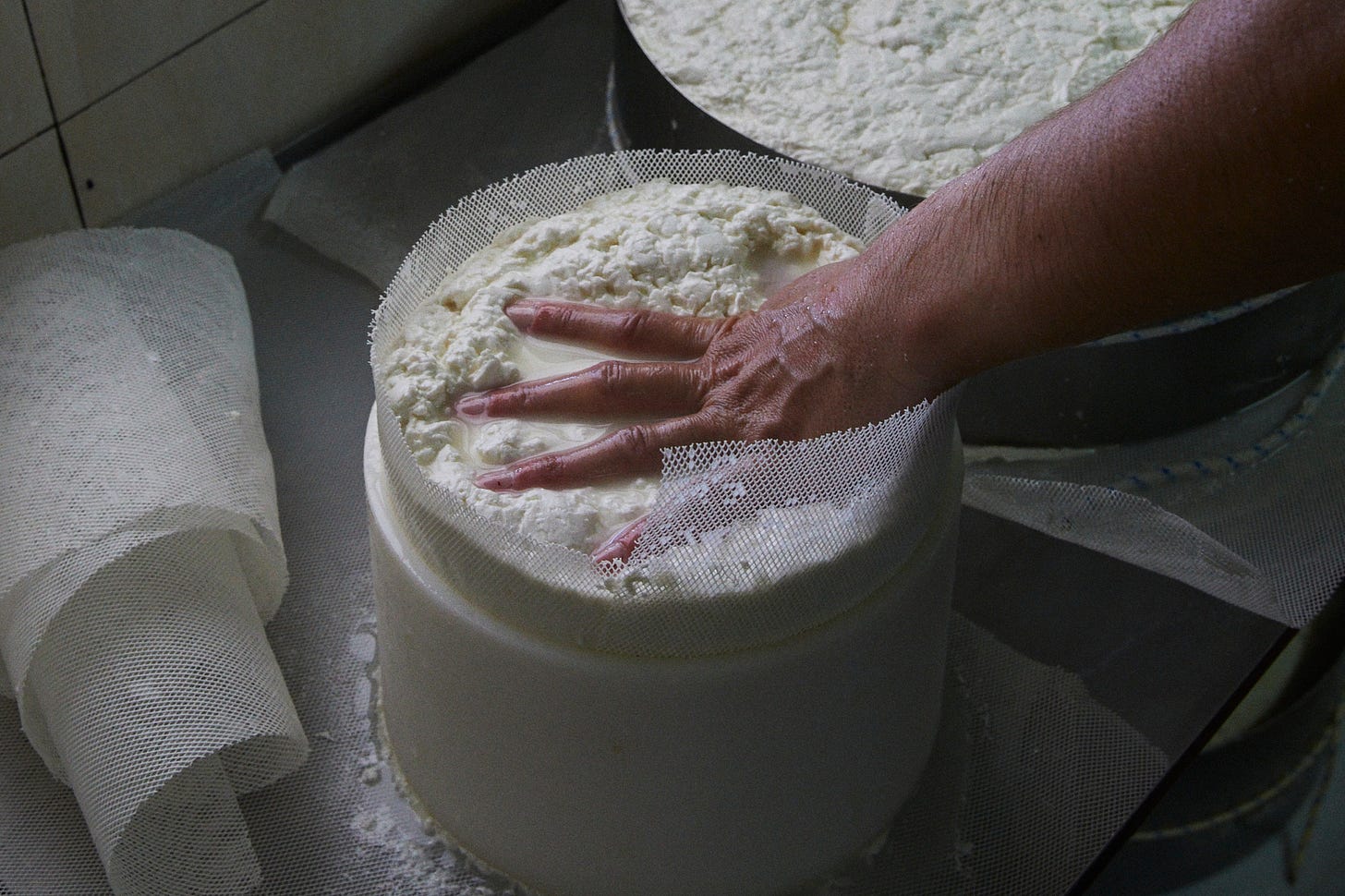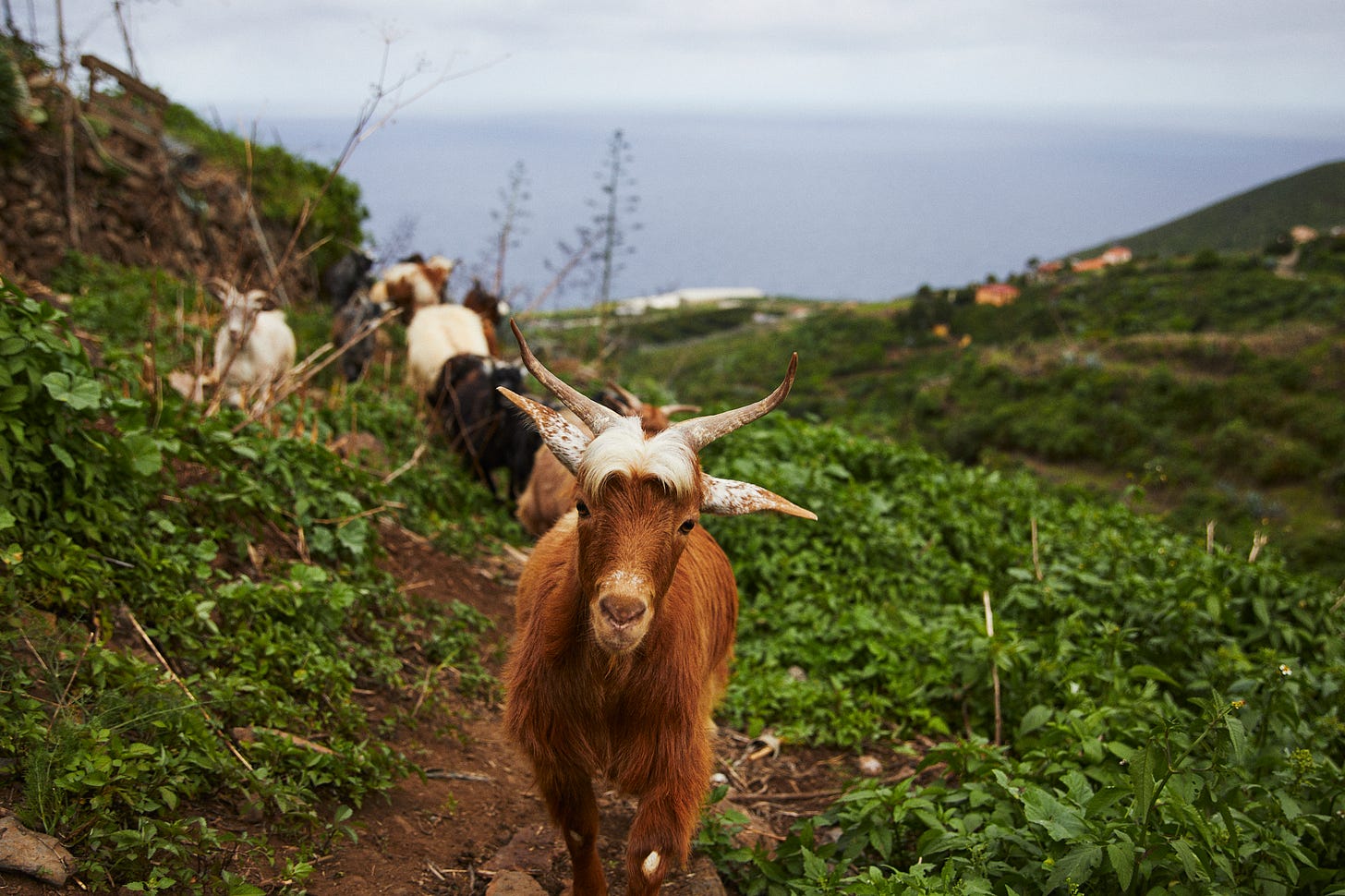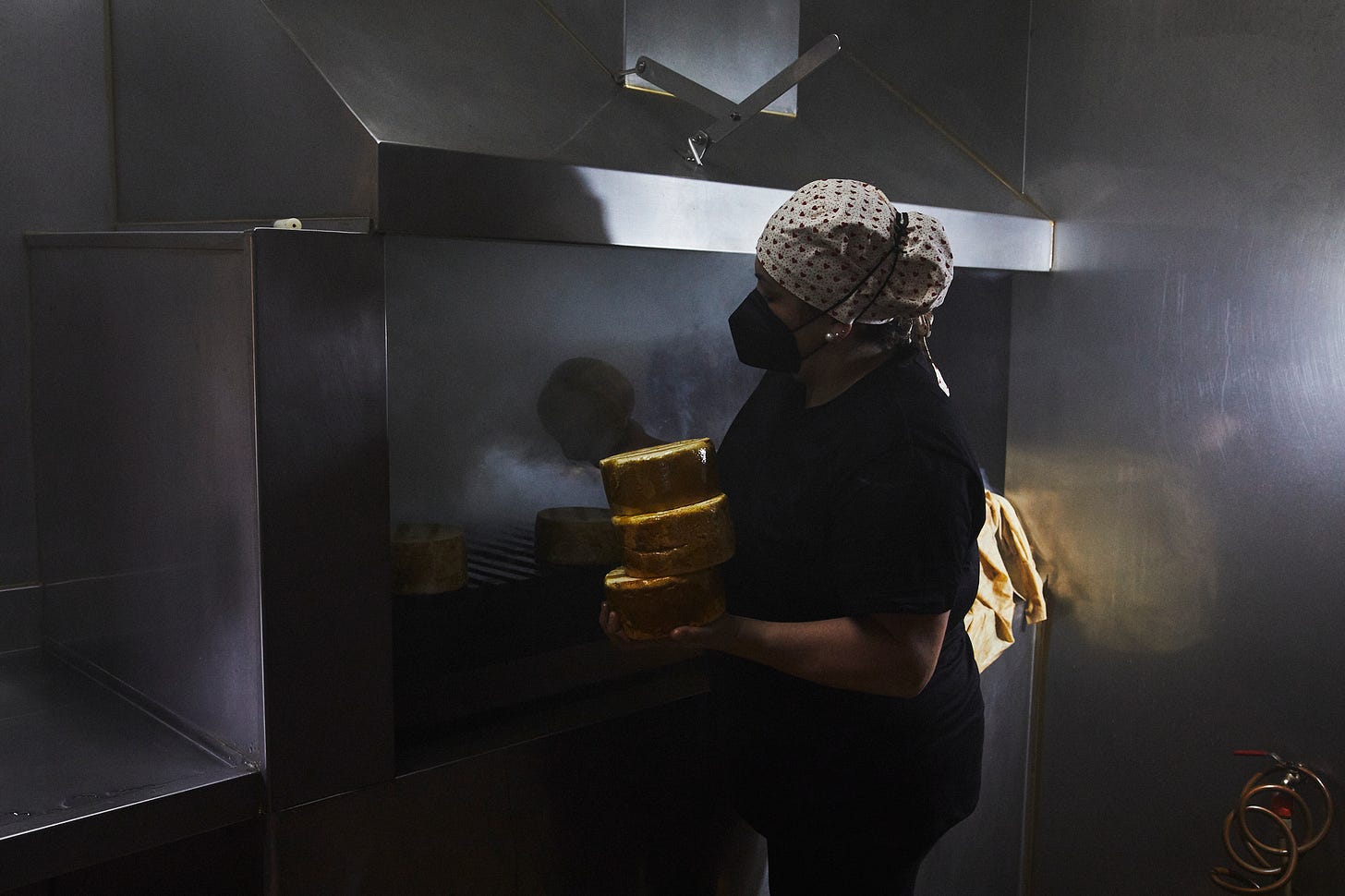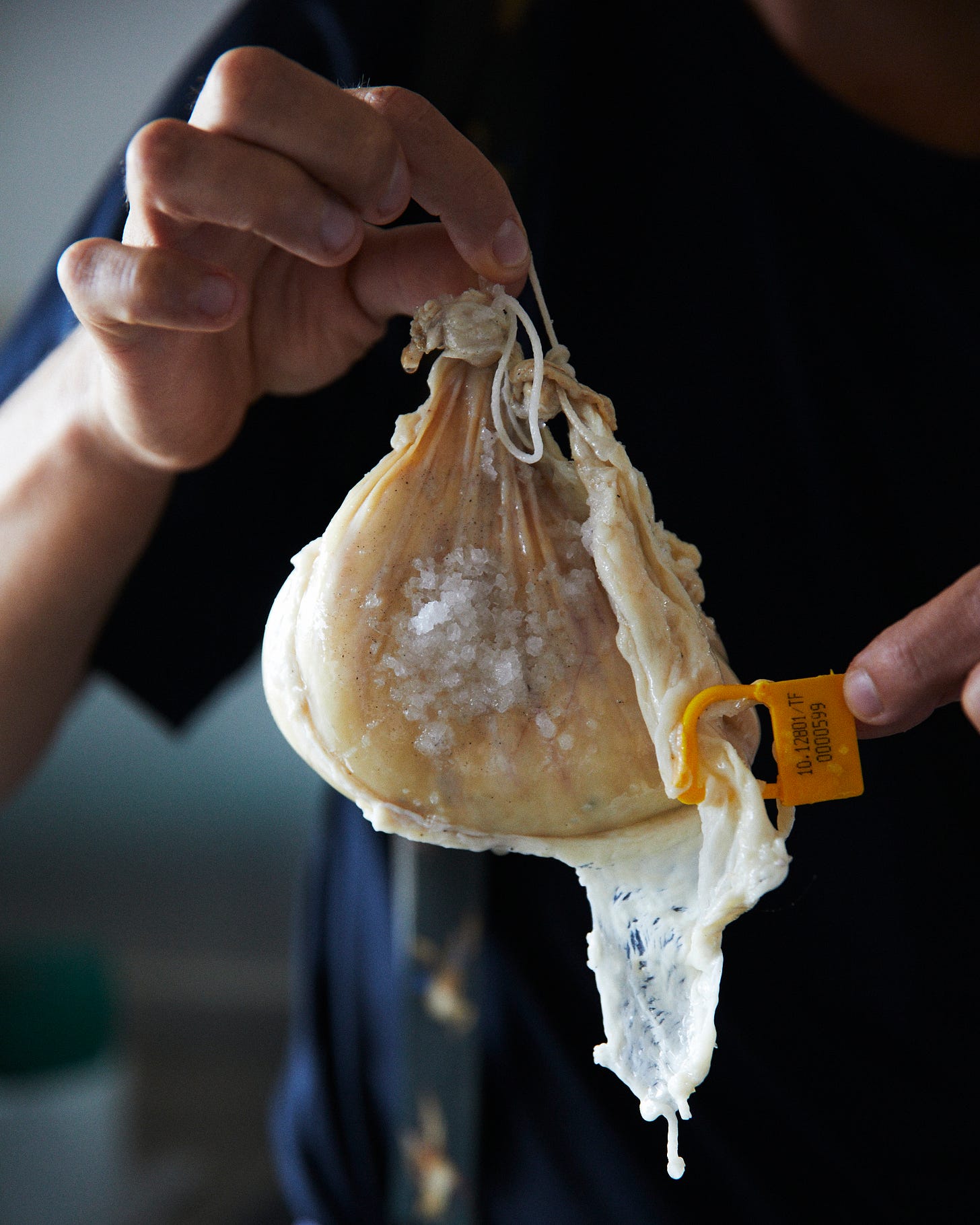Cheeses of the Canary Islands: La Palma, the Palmera goat, rennet, and coagulant sovereignty.
Documenting the traditions of pastoralist cheesemakers for my DZTA research.
La Palma, the youngest of the Canary Islands, is still growing from active volcanic vents. Its steep, canyon carved sides rise quickly to high mountains, with calderas and cinder cones. It receives more rain than the other islands, earning it the title Isla Verde. The north and east sides look similar to Hawaii in places, with volcanic rock and rugged cliffs riddled with caves, palm and banana trees, and huge succulents and cactus. The island has gone through a series of historical monocrop boom-busts, including tobacco, wine grapes, and now bananas. What seems to have lasted through these waves is a pastoral cheese tradition rooted in the pre Spanish Guanche culture.
The goat is the dominant type of livestock here, and farmers overwhelmingly stick to the breed of the island, the Palmera goat. It is a small scrappy goat, with long hair along its spine and rear legs. Many sport a bouffant or bangs with insolent pride. There are many coat patterns and colors, a trait I use to instantly identify a heritage breed that hasn’t been bred for conformity to uniformity. These goats are punk as fuck, just look at them, climbing rocks and not giving a shit. Four hooves on the ground, chins pointed at the eternal La Palma sky, blue by day, star studded by night. These goats and their human partners have a statement. We are still here
The origins of the breed are unclear. It is thought to be a mixture of the goats raised here pre Spanish conquest, and those brought by European settlers, many of whom used the islands as a stopping point on transatlantic trips to the Americas. Some of the first cheeses shipped to the Americas where from this island, and I am curious if some of the people from La Palma who moved to Cuba and Venezuela took the techniques and goats along with them.
Queso Palmero is a protected name cheese, but there are actually a range of cheeses made inside and outside the DOP by the same makers, utilizing similar techniques and equipment, but producing slightly different cheeses. For me, this is so much more interesting than places where everyone makes nearly indistinguishable cheeses that all get aged and distributed by a consortium. From my travels and reading it seems like in many places there are cheeses and other foods that are typical for a region and its people. Within this, there are often minor variations, micro-regional preferences, makers of particular renown, and debate over who makes the best and most true cheese. This “traditional” variation is too often lost in the marketing and rigid rule setting of GI protected names and DOP politics. Luckily this hasn’t happened yet on La Palma, and the DOP has some solid points, such as requiring the use of the Palmera Goat.
The cheeses here are often smoked, especially a version aged for just a few weeks called Tierno, fitting between Fresco and Semi-curado on the Spanish cheese age staircase. There are many plants, trees, nut shells, and even cactus used as fuel, and often a combination is used. Pine needles seem to be very common, often combined with the dried skeleton of Opuntia (such as prickly pear) cactus. I never considered how significant the impact could be of different fuels, but the makers here have a strong sense of this, and the fuel type is used as a regional or familial identifier for their cheese. The level of smokiness that is preferred also varies on different parts of the island. I was told that chestnut is the best, but most work with something abundant in their area.
The cheeses are only smoked for 10-20 minutes, but the smoke is thick and leaves a brown layer on the cheese that is immediately washed off. Left behind are orange/brown grill marks where the cheese rested on a blackened grate. Most smoked cheeses undergo long cold smoking, but this is a fast hot smoking. It imparts a light smokiness that is mainly on the rind, and in the older cheeses can be barely distinguishable. I imagine this is an adaptation for preservation with a lack of cold aging spaces, combined with a long history of cheese exportation. Methods to preserve humidity include coating cheese in a ground grain mixture called gofio, olive oil, and/or a heavy dose of pimenton or cumin. Many cheese fanatics see the use of smoke and herbs or seasoning as gimmicks, but in many places these things are highly traditional and functional.
The main aspect that drew me to La Palma is the living tradition of farmer/cheesemakers making rennet from their own goats. This is a practice that has been abandoned in most of the world, but they cling to it tenaciously here. The majority of kids are born in Winter and early spring, and the males slaughtered at 15-20 days old. At this point they have only fed on their mothers milk, and their abomasums still have a high ration of Chymosin to Pepsin. This ratio shifts as they get older, which is why most rennet making involves the butchering of very young animals. This is also practical, as the males born each year generally don’t have a role to play on the farm, and are extra mouths to feed.
The kids are slaughtered at a facility on the island, that meets EU standards. They attach a traceable tag with an ID number, and the stomachs are given back to the makers. My understanding is that the abomasums are empty at this point, and the makers fill them with milk, that coagulates inside. They are tied off to keep the contents in, placed in a container, then covered with salt. This salt pulls moisture out, which becomes a brine with a slightly gelatinous feel to it. The stomachs and some of the brine can be removed one at a time and made into a liquid. I am told one stomach will coagulate around 1200 liters of milk. Of course, It depends on the milk and the style of cheese, but it seems reasonable that by using all the males born in a given year one can obtain enough rennet to be self sufficient. I’ve heard this claim made by goat and sheep farmers in various places. That assumes a large enough herd size to have an average of around 50% males, and I assume it would be true with cows as well, but may depend on the length and total quantity of lactation for a given herd.
The past three weeks spent on these islands has been a crucial phase of my research project for the Daphne Zepos Teaching Endowment. The level of coagulant sovereignty is very high, as the use of homemade thistle preparations on Gran Canaria, and farm level goat rennet on La Palma are considered crucial. Of course, the use of synthetic rennet and thistle coagulant prepared on the mainland is becoming increasingly common. So it is a great place to learn how these ingredients shapes cheese flavor. Like most places I go, the traditions, and the culture, are not static, but are shifting and adapting. The fact that these practices still exist, and that paths have been cut to bring them into the modern regulatory climate, is encouraging. Cheesemakers can easily make their own animal and vegetable coagulants. The only difficulty is in having these practices sanctioned by the state.
Photos by Alexander Pomper.














